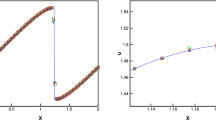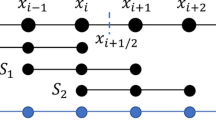Abstract
The numerical method used to solve hyperbolic conservation laws is often an explicit scheme. As a commonly used technique to improve the quality of numerical simulation, the \(h\)-adaptive mesh method is adopted to resolve sharp structures in the solution. Since the computational costs of altering the mesh and solving the PDEs are comparable, too often the mesh adaption triggered may bring down the overall efficiency of solving hyperbolic conservation laws using \(h\)-adaptive mesh method. In this paper, we propose a so-called double tolerance adaptive strategy to optimize the overall numerical efficiency by reducing the number of mesh adaptions, as well as preserving the quality of the numerical solution. Numerical results are presented to demonstrate the robustness and effectiveness of our \(h\)-adaptive algorithm using the double tolerance adaptive strategy.












Similar content being viewed by others
References
Harten, A.: High resolution schemes for hyperbolic conservation laws. J. Comput. Phys. 49(3), 357–393 (1983)
Sweby, P.K.: High resolution schemes using flux limiters for hyperbolic conservation laws. SIAM J. Numer. Anal. 21(5), 995–1011 (1984)
Berger, M.J., Oliger, J.: Adaptive mesh refinement for hyperbolic partial differential equations. J. Comput. Phys. 53(3), 484–512 (1984)
Berger, M.J., Colella, P.: Local adaptive mesh refinement for shock hydrodynamics. J. Comput. Phys. 82(1), 64–84 (1989)
Sleigh, P.A., Gaskell, P.H., Berzins, M., Wright, N.G.: An unstructured finite-volume algorithm for predicting flow in rivers and estuaries. Comput. Fluids 27(4), 479–508 (1998)
Skoula, Z.D., Borthwick, A.G.L., Moutzouris, C.I.: Godunov-type solution of the shallow water equations on adaptive unstructured triangular grids. Int. J. Comput. Fluid Dyn. 20(9), 621–636 (2006)
Liang, Q., Borthwick, A.G.L.: Adaptive quadtree simulation of shallow flows with wet-dry fronts over complex topography. Comput. Fluids 38(2), 221–234 (2009)
Ganesh, N., Balakrishnan, N.: A \(h\)-adaptive algorithm using residual error estimates for fluid flows. Commun. Comput. Phys. 13(2), 461–478 (2013)
Tang, H., Tang, T.: Adaptive mesh methods for one- and two-dimensional hyperbolic conservation laws. SIAM J. Numer. Anal. 41(2), 487–515 (2003)
Han, E., Li, J., Tang, H.: Accuracy of the adaptive GRP scheme and the simulation of 2-d Riemann problems for compressible Euler equations. Commun. Comput. Phys. 10(3), 577–606 (2011)
Forestieri, G., Guardone, A., Isola, D., Marulli, F., Quaranta, G.: Numerical simulation of compressible vortical flows using a conservative unstructured-grid adaptive scheme. Commun. Comput. Phys. 12(3), 866–884 (2012)
Kroner, D.: Numerical Schemes for Conservation Laws. Wiley, Chichester (1997)
Tang, H.Z., Warnecke, G.: On convergence of a domain decomposition method for hyperbolic conservation laws. SIAM J. Numer. Anal. 45(4), 1453–1471 (2007)
Berger, M.J., LeVeque, R.J.: Adaptive mesh refinement using wave-propagation algorithms for hyperbolic systems. SIAM J. Numer. Anal. 35(6), 2298–2316 (1998)
de Boor, C.: Good Approximation by Splines with Variable Knots II, Volume 363 of Lecture Notes in Mathematics. Springer-Verlag, Berlin (1974)
Burchard, H.G.: Splines (with optimal knots) are better. Appl. Anal. 3(4), 309–319 (1974)
Van Leer, B.: On the relation between the upwind-differencing schemes of Godunov, Enguist-Osher and Roe. SIAM J. Sci. Stat. Comput. 5(1), 1–20 (1985)
Deng, J., Li, R., Sun, T., Wu, S.N.: Robust a simulation for shallow flows with friction on rough topography. Numer. Math. Theory Methods Appl. (2012)
Li, R., Liu, W.B.: http://dsec.pku.edu.cn/~rli/AFEPack-snapshot.tar.gz
Li, R.: On multi-mesh h-adaptive methods. J. Sci. Comput. 24(3), 321–341 (2005)
Rogers, B.D., Borthwick, A.G.L., Taylor, P.H.: Mathematical balancing of flux gradient and source terms prior to using Roe’s approximate Riemann solver. J. Comput. Phys. 192(2), 422–451 (2003)
Liang, Q., Borthwick, A.G.L., Stelling, G.: Simulation of dam- and dyke-break hydrodynamics on dynamically adaptive quadtree grids. Int. J. Numer. Methods Fluids 46(2), 127–162 (2004)
Hubbard, M.E.: Multidimensional slope limiters for MUSCL-type finite volume schemes on unstructured grids. J. Comput. Phys. 155(1), 54–74 (1999)
Kawahara, M., Umetsu, T.: Finite element method for moving boundary problems in river flow. Int. J. Numer. Methods Fluids 6(6), 365–386 (1986)
Brufau, P., Vázquez-Cendón, M.E., García-Navarro, P.: A numerical model for the flooding and drying of irregular domains. Int. J. Numer. Methods Fluids 39(3), 247–275 (2002)
Hervouet, J.M., Petitjean, A.: Malpasset dam-break revisited with two-dimensional computations. J. Hydraul. Res. 37(6), 777–788 (1999)
Hervouet, J.M.: Hydrodynamics of Free Surface Flows: Modelling with the Finite Element Method. John Wiley & Sons Inc, London (2007)
Valiani, A., Caleffi, V., Zanni, A.: Case study: Malpasset dam-break simulation using a two-dimensional finite volume method. J. Hydraul. Eng. 128(5), 460–472 (2002)
Acknowledgments
This research is supported by ExxonMobil Upstream Research Company. We thank Dr. Tao Sun for his informative and instructive discussion with us. We would like to thank the anonymous referees sincerely for their suggestions and comments so constructive and detailed.
Author information
Authors and Affiliations
Corresponding author
Rights and permissions
About this article
Cite this article
Li, R., Wu, S. \(H\)-adaptive Mesh Method with Double Tolerance Adaptive Strategy for Hyperbolic Conservation Laws. J Sci Comput 56, 616–636 (2013). https://doi.org/10.1007/s10915-013-9692-1
Received:
Revised:
Accepted:
Published:
Issue Date:
DOI: https://doi.org/10.1007/s10915-013-9692-1




